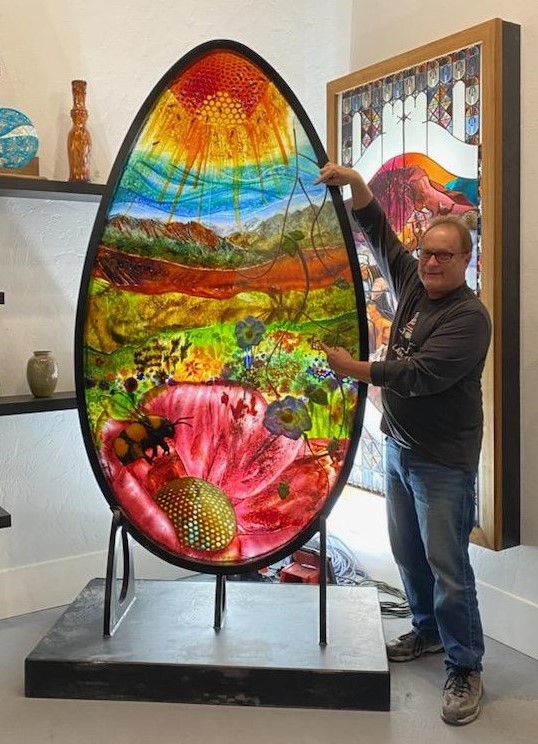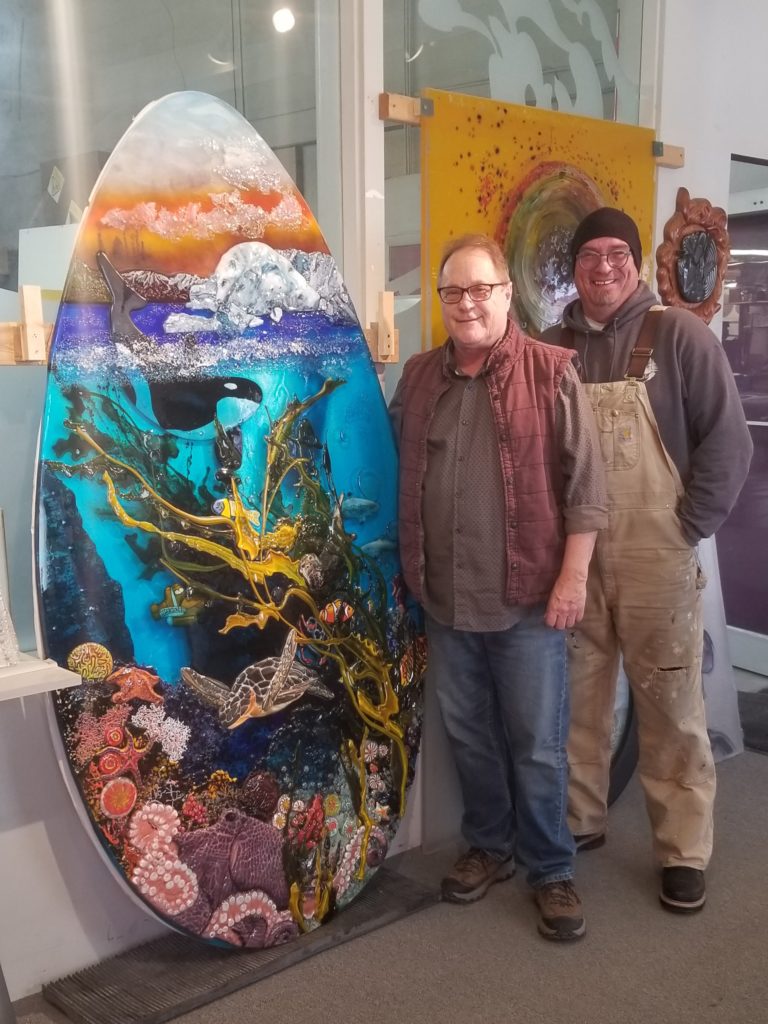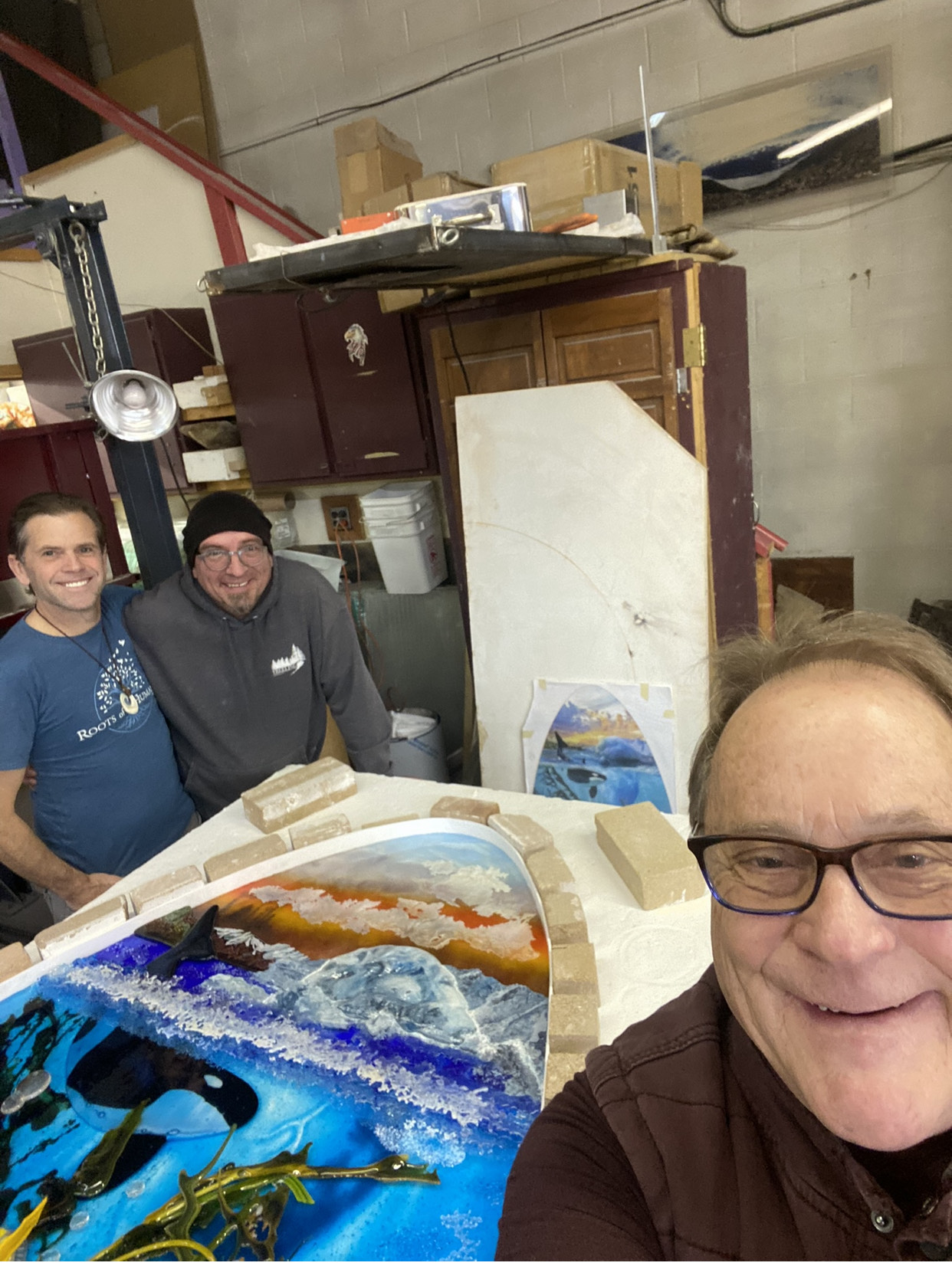by Sheena Wolfe
In an unassuming studio at the end of a Salt Lake City side street the art of two local artists is about to get international attention. Kiln-formed glass artists Kerry Transtrum and Stephen Teuscher have recently completed two extraordinary giant glass ovals – one depicting the life cycle of the honeybee and the other an ocean landscape – that are going on tour around the world, and will eventually be two of 14 skylights in a planned glass education complex called the Roots of Humanity Campus, slated to be built at Thanksgiving Point.

The ovals – referred to as nesting eggs – will tour with up to seven stained-glass panels called the Seven Pillars of Humanity created by Tom Holdman of Holdman Studios, Lehi. The two completed skylights are one and one-half inches thick, 81 inches tall, 42 inches wide, and largely made from tiny pieces of colored frit glass. In addition, the eggs each have added elements. The ocean scene has over 100 add-ons including dozens that were created from sculpted clay, which was then molded in glass, kiln fired, then added to the larger structure, said Tuescher. Each oval took months to design and complete. The firing time alone for each piece took more than a week in a specialized eight-foot kiln.
The nesting egg concept began several years ago when Holdman, a Roots of Humanity Foundation artist, discussed with Transtrum and Teuscher his dream to build the largest glass facility and education center in the world. The finished building is expected to contain at least 11,000 square feet of stained and kiln-formed glass when it is completed in approximately four years. Holdman’s Seven Pillars of Humanity are seven feet tall and three and one-half inches wide and are already world-famous. They were created to illustrate seven key characteristics that humans are capable of: Knowledge, Creativity, Faith, Love, Unity, Freedom and Courage. When the Roots of Humanity complex is completed, these panels are expected to be placed as walls in the planned glass facility.
“The glass scene in Utah is relatively small, so everyone knows everybody,” said Transtrum, as to how he and Teuscher ended up working on the Roots of Humanity project. “Tom is good at stained glass and he knew we were skilled with fused glass,” he said, noting that Holdman approached him last year to do the first skylight for a Salt Lake City fundraiser. “Now we’ve finished two of the skylights and hope to work on the next twelve, as well. The pillars depict scenes of humanity, but the skylights are about nature and how nature is crucial to our survival. And like the pillars, the eggs are meant to tell a story.”
He explained that the first nesting egg is all about bees because honeybees around the globe are in danger of dying out, largely due to pesticide sprays. “We have had bees since ancient times,” he said, “and if they die out natural pollination, needed for all our fruits and vegetables, will cease to exist.”
The bee egg, named “Bee Remarkable,” depicts a large honeybee in a sunny nature scene that includes all the areas that bees can be found including the dessert, mountains and gardens, Transtrum said, noting that a large flower at the base of the piece contains a honeycomb center that is also a globe of the earth highlighting the Asian continent where bees were first found.
“Since bees are considered a keystone species the sun at the top of the piece is in a keystone shape, as well as having a beehive design,” he said. “In addition, the entire piece was designed in horizontal layers depicting the horizontal lines on an actual bee.”
It is hard to see in the photos but a separate clear glass wing has been overlayed onto to the skylight to complete a bee shape, Transtrum said, and etched into the wing are actual ancient bee petroglyphs found in Egyptian caves. Also, painted into the glass is an ancient Spanish pictograph showing how beekeepers used to scale mountains cliffs to obtain honey from the bees, said Tuescher.
The second egg, named “We All Live,” shows a vibrant ocean scene with a variety of sea plants and animals including an orca whale, several fish species, a sea turtle, several star fish, various sea anemone and waving kelp made with glass stringers, said Teuscher. The skylight also includes a yellow submarine on which is written “We All Live,” taken from the Beatles’ song “Yellow Submarine.” Less visible objects in the design include a family of polar bears, a human heart and two jellyfish that were created by recently deceased glass artist Onno Mattheus. In addition, a polluted city fills the left skyline, and a discarded water bottle and plastic ring from a six pack have been included in the art piece to bring attention to the toxic garbage that is filling our oceans. Plant and animal life will not survive if pollution continues at its current rate, said Teuscher, noting that messages such as recycle, and re-use are written on the flowing kelp.

Working on the eggs brought both Transtrum and Teuscher personal awareness of how fragile our environment has become. “In working on these two skylights,” said Teuscher, “I have become a better person in humanity. I am also focused on bettering myself. I have focused on the idea that we are all humans with more similarities than differences. And we all need to work together on our planet. We are all part of the human race.”
“When we first learned of the Roots of Humanity project, we never dreamed that we would become so involved,” said Transtrum, noting that the eggs have taken all their knowhow and ingenuity to produce. “We have used every technique we know and made up some new ones,” he said, adding that in the process of creating the first two eggs he and Teuscher have educated themselves about bees and the ocean. One fact that many might not know, he said, is that sea plants provide most of the earth’s oxygen. “That seems enormous,” he said.
Transtrum has been working with fused glass for more than 35 years. Teuscher was already a well-known painter and sculptor before discovering kiln-form glass about 10 years ago.

“We are so honored to be working with the Roots of Humanity,” said Transtrum. “We are so lucky to be able to contribute to the bettering of ourselves and our planet.”
“Millions of people will be inspired by our creations,” said Teuscher, “that makes us very humble and grateful. This work will reach people from all over the world. Our hope is that they will be influenced to join the fight to save humanity and our planet.”
According to its website, the Roots of Humanity Foundation “works through art and education to foster esteem, connection and creativity within individuals while unifying and inspiring communities.”
For more information on the foundation go to rootsofhumanity.org. For more information on Transtrum and Teuscher type their names into any search engine.
Courtesy of West View News 2023